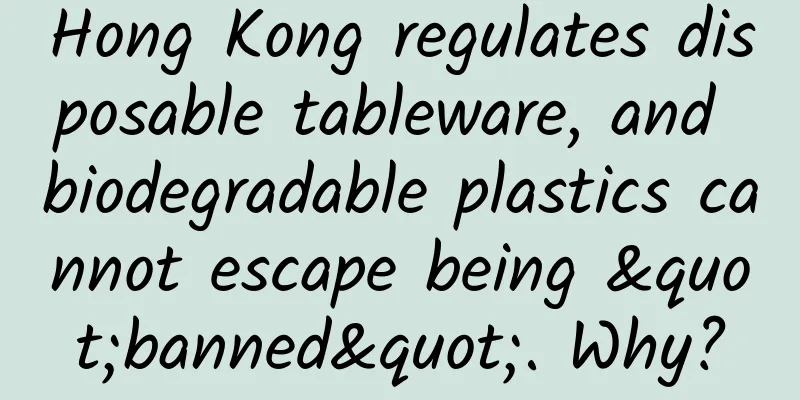Hong Kong regulates disposable tableware, and biodegradable plastics cannot escape being "banned". Why?

|
Every year, countless waste plastics drift into the ocean and other natural environments, eventually breaking into microplastics and entering the human food chain. The Hong Kong government is proposing to legislate to ban disposable plastic tableware, and its public consultation period has just ended. Careful people have discovered that "biodegradable plastics," which are considered an environmentally friendly alternative to non-degradable plastics, are also within the scope of regulation. Types of disposable plastic tableware to be controlled in Hong Kong The Hong Kong government has very good reasons: in recent years, a number of "alternative plastic" products claiming to be degradable or biodegradable (such as oxo-degradable plastics, biodegradable plastics, etc.) have appeared on the market, but in fact, most of these biodegradable plastic products can only be accelerated to break into microplastic fragments or be biodegraded under specific conditions, such as sufficient ultraviolet rays or heat. They are not able to degrade quickly and naturally under all natural environmental conditions, such as the natural marine environment. As there is insufficient data to prove that these products can be completely biodegraded within a reasonable time in the marine environment, the Hong Kong Environment Bureau recommends that the control scheme should cover all types of plastic disposable tableware, including thermo-oxidative degradable plastics and biodegradable plastics. Image | pexels The emergence of degradable plastics is seen by many as a "savior" to solve plastic pollution, and the degradable plastics industry has developed rapidly. But are degradable plastics definitely more environmentally friendly? More and more scientific studies have raised questions. This time, the Hong Kong government made its position clear on degradable plastics, pointing out the technical difficulties that degradable plastics have too high requirements for the degradation environment and the feasibility of degradation is very small. It also regulated the current degradable plastic tableware together with disposable plastic tableware, which was tantamount to pouring cold water on the hotly expanding degradable plastic industry and caused quite a stir. Degradable plastics: the ideal is beautiful, but the reality is bleak Degradable plastics usually include biodegradable plastics, photodegradable plastics and thermo-oxidative degradable plastics. Whether photodegradable plastics and thermo-oxidative degradable plastics can be completely degraded has been controversial, and they are even called "pseudo-environmentally friendly". Therefore, here we will focus on the most popular biodegradable plastics. Biodegradable plastics refer to a type of plastic that can be completely degraded by microorganisms in nature under certain environmental conditions into carbon dioxide (CO2) and/or methane (CH4), water (H2O) and mineralized inorganic salts of the elements they contain. As one of the plastic alternatives, biodegradable plastics have been highly anticipated since their inception. The types of biodegradable plastics that have been industrialized include polylactic acid (PLA), polybutylene terephthalate (PBAT), polyhydroxyalkanoate (PHA), polypropylene carbonate (PPC), etc. Among them, PBAT is the main raw material used for film bags, and PLA is the main raw material used for tableware, injection molding, and fiber. Other types of biodegradable plastics are mainly used in high-end fields, and with the improvement of performance and the continuous reduction of costs, they have begun to be used in the fields of daily necessities such as fibers and agricultural mulch films. With the continuous deepening of my country's plastic pollution control policies, the biodegradable plastic industry has developed rapidly. In terms of production capacity, my country's annual production capacity of PBAT and PLA in 2020 will be about 300,000 tons and 100,000 tons respectively, accounting for about half of the global production capacity. It is expected that by 2025, my country's annual production capacity of PBAT and PLA will be around 7 million tons and more than 1 million tons, accounting for more than 2/3 of the global production capacity. From the perspective of standards, standards in the field of biodegradable plastics are gradually being improved. Among the ISO international standard test methods for biodegradation, my country has converted 11 items into equivalents. From the perspective of testing capabilities, the number of institutions capable of testing the degradation performance of biodegradable plastics is increasing rapidly. There are about 15 laboratories that are recognized by peers or certification agencies such as DIN CERTCO and BPI. However, at present, there are still many difficulties that need to be overcome in the production, circulation, use, recycling and disposal of biodegradable plastic products in my country. For example, it is necessary to carry out life cycle assessment to clarify in which scenarios the application of biodegradable plastics has obvious environmental benefits, and to combine the implementation of garbage classification to clarify the classification collection and classification treatment methods of biodegradable plastic waste. Figure | Network In December 2020, Beijing University of Petrochemical Technology and the Natural Resources Defense Council jointly released the "Environmental Footprint Assessment of Plastics in China" report, which evaluated the environmental footprint of degradable plastics. The report analysis shows that: the environmental performance of different categories of degradable plastics varies significantly; in the field of plastics, "degradable" is not synonymous with resource conservation and environmental friendliness; the intrinsic carbon age of plastics and their position in the product chain largely determine their relative environmental friendliness. The assessment report points out that the treatment system for discarded biodegradable plastics will determine whether they can truly play an environmental advantage: 1. When the fate of degradable plastics is set by the system to be incinerated, fossil-based degradable plastics are even less environmentally friendly. There is an obvious conflict between the policy goal of source control based mainly on degradable plastics and the actual management based mainly on incineration. 2. When PPC production raw materials come from the high-energy consumption and high-emission chlorohydrin process, the same is true for carbon-based biodegradable PPC plastics. 3. When plastics are discarded in most places after use, the carbon in PLA products is essentially no different from the carbon in fossil energy, and both are "sleeping historical black carbon." Are we ready for biodegradable plastics? At present, the degradation conditions of biodegradable plastics are relatively harsh, and they must be rapidly degraded under composting conditions, which raises two very realistic problems: 1. When the degradation conditions are not met, biodegradable plastics are the same as traditional non-degradable plastics. The degradation of microplastics will not only be very slow, but also cause pollution; Second, biodegradable plastics need to be distinguished from other garbage and composted separately, a process that will increase the cost of garbage sorting and composting. Mainstream biodegradable plastics still rely mainly on composting for degradation, which requires a high temperature of around 60 degrees Celsius and composting soil to degrade within 3-6 months. However, the average surface temperature of the world's highest seawater is about 17.4 degrees Celsius, which is far below the temperature required for composting degradation, not to mention that seawater lacks enzymes and microorganisms that can decompose ester bonds. Therefore, even the biodegradable plastics or compostable plastics that are basically recognized at present will also cause great pollution to the ocean if they are produced as disposable plastic products and discarded into the ocean. Figure | Network Ideally, degradable plastic products should be placed in wet garbage bins and then transported to waste treatment plants for composting. However, in actual operations, the degradation rate of degradable plastic products is far slower than that of wet garbage. For efficiency reasons, waste treatment plants are currently reluctant to treat degradable plastic products together with wet garbage. The lack of mandatory standards for the labeling of degradable plastic products is another difficulty in their application and promotion. The terms "degradable", "biodegradable" and "compostable" indicate that certain plastic products or packaging have degradable environmental characteristics, which are called environmental claims. When a plastic product claims to be degradable, it does not mean that the product can be completely degraded in any environment in a short period of time. Therefore, making statements such as "degradable" on plastic products is misleading in itself, unless such statements are accompanied by sufficient restrictive instructions, including but not limited to the environmental conditions and time range required for degradation. Reliable and responsible environmental claims can help consumers decide which products to buy and guide them to use and dispose of products in a responsible manner. Environmental claims that are imprecise, vague, incomparable, unverified or irrelevant often undermine fair competition in the market and have a negative impact on the credibility of credible standards and claims. A study on littering behavior among young people found that biodegradable plastics were one of the reasons why individuals mismanage their waste, while another study noted that consumers were “shocked and disappointed” when they learned that most biodegradable plastic products required back-end processing in industrial composting conditions. Biodegradation is difficult, how to solve it? Faced with the environmental dilemma of promoting the use of biodegradable plastics, many countries and regions have already introduced more stringent countermeasures long before the Hong Kong government took action. Figure | Network California has passed strict laws regulating the marketing and labeling of degradable plastic products sold in California, including those claiming to be "degradable" or "biodegradable." Environmental marketing claims must be supported by reliable scientific evidence and meet prescribed standards to prevent misleading consumers about the environmental impact of degradable plastic products. From October 1, 2018, the state of Maryland prohibits anyone from selling certain plastic products labeled as biodegradable, degradable or decomposable, with certain exceptions; and prohibits anyone from selling specified plastic products labeled as compostable or home compostable, unless the plastic product meets the specified standards. In response to the ban, the state establishes specified penalties and stipulates specific penalties. In Canada, plastic bags have been banned in Toronto since 2013. The ban includes "degradable, biodegradable, photodegradable or similar materials." The UK does not support the widespread use of industrial compostable packaging at this stage, because the general waste management infrastructure for managing industrial degradable plastic packaging is not yet suitable for use. For general consumer packaging, the UK believes that without dedicated compostable bins, consumers may be confused about how to deal with compostable packaging, which may lead to recycling contamination of ordinary plastics (if biodegradable plastics are mixed into the recycling process of ordinary plastics, it can lead to a decline in the quality or durability of the recycled products) and littering. However, closed environments can be exceptions, such as sports events and workplaces with catering facilities, which have dedicated processing and collection services. In fact, the "14th Five-Year Plan" Action Plan for Plastic Pollution Control issued by my country's National Development and Reform Commission and the Ministry of Ecology and Environment in September this year has mentioned that it is necessary to scientifically evaluate the resource and environmental impact of degradable plastics throughout their life cycle. This is a good signal, indicating that decision makers are also aware of the problem of "degradable plastics" being blindly promoted and lacking supervision. "Environmental Footprint Assessment of Plastics in China" points out that the current plastic economy is still open-loop and linear, and the degree of material closure needs to be improved. Sustainable plastics: From linear to closed-loop material flows Promoting the plastic economy from an open-loop linear model to a closed-loop circular model is a systematic change involving theory, technology, management, production, and consumption. It requires the participation of all industrial sectors and consumers in society, and requires government departments to quickly improve the plastic ban and restriction policy framework for the entire industrial chain. Recommended reading: "Why are these countries so cautious about biodegradable plastics?" Research | Biodegradable plastics do not equate to low environmental impact "How to solve the dilemma of application and promotion of biodegradable plastics?" References [1]https://kdocs.cn/l/cqWJhKLWtEDDHong Kong Draft for Comments on Control of Disposable Plastic Items.pdf [2] Yang Yunpeng. Research status and prospects of biodegradable plastics[J]. Chemical Engineering Management, 2019(18):14. [3] https://baijiahao.baidu.com/s?id=1710948820230035784&wfr=spider&for=pc Scientifically understand biodegradable plastics and other plastic substitutes to guide the orderly development of related industries -End- Editor: Li Lan, Breaking Free from Plastic |
<<: The heavy rain in Shanxi was caused by the blocking of the northwest wind?
Recommend
Beijing becomes a major center for autonomous driving testing; three future innovation centers will help the development of intelligent transportation
At yesterday's "World Intelligent Connec...
Why do we need to build an Apple bidding intelligent delivery platform?
It was somewhat difficult to adapt to the transit...
Practical explanation | Don’t you know how to use Tik Tok feed flow to attract traffic in your live broadcast room?
In this year of fear, disaster, and magic, a sudd...
WeChat official: WeChat circles will be closed soon, please back up quickly
[[402336]] WeChat officially announced today that...
What should I do if the display volume of information flow ads is low? Must-read traffic optimization tips!
How to run information flow advertising ? Who sho...
Cold knowledge | The way to get rid of pain is to live well
One minute with the doctor, the postures are cons...
O2O transforms traditional service industry in many ways, taking hairdressing as an example
The hairdressing industry is a basic need for mos...
I get shocked when I disagree with something. Why does static electricity always come to me?
Audit expert: Zhou Hongzhi Senior Experimentalist...
180 courses on in-depth practice of short videos on Douyin
Course Overview This is a set of in-depth practic...
World Earth Day | How many people can the earth support?
As early as 2012, the academic journal Journal of...
Official account: Niantian Jue Xue Niantian Jue Ji (Part 2) Fault series video
Official account: Nian Tian Jue Xue Nian Tian Jue...
How about Pampers diapers: How does Chengdu SEO optimization use external links to attract traffic?
Many webmasters encounter this problem: the SEO o...
"Hot-selling" down jackets are trending! When wearing down jackets, it is best not to do these things...
Temperatures have risen in many places recently I...
How to write a hot topic title? Share 5 tips!
Hot topic titles have always been one of the more...
The U.S. health department responded to Li’s refusal to take a test. She has been diagnosed but has been unsuccessful in trying to contact her many times!
On March 20, the Belmont Health Department in Mas...









